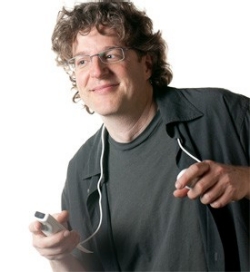This evolution has led to a change of demographics from teenager to adult; the average Canadian player is now in his or her mid-30s. Production of these games has also become a huge industry, and Canada is the third biggest producer worldwide.
Despite this large offering and history, video games still get a bad rap. Parents, spouses, school boards and even governments see gaming as non-productive, antisocial and addictive. The common sentiment is that video games are a waste of time and consequently have no value.
Gamers as artists
But what if the player were viewed as an artist — an actor who interpreted scenarios and played out dramas? Would perceptions change if the game creators were appreciated as choreographers? Would this bring new meaning and authenticity to this pastime?
This new perspective is what William Robinson, MA 12, examined in his master’s thesis.
“The goal of my project was to see if I could bring a new appreciation to the gaming world,” says Robinson, who was supervised by Bart Simon, associate professor in Concordia’s Department of Sociology and Anthropology. “My thesis asked whether it’s possible to define gamers [those who play video games] as artists and their games as pieces of art.”
The caveat, he adds, is that not all games and not all players can be included in the art category — just as not all paintings can be defined as artistic.
What is art?
Robinson’s first step was to define art. He chose to focus on the criteria of creativity, value and flair.
“Being original and doing something that you or someone else hasn’t done before seems to be an important characteristic of art,” he says. “Bringing value, worth or recognition to the object is also an important distinction, as well as flair, which involves taking a risk and not knowing the end result.”
Robinson suggests Starcraft One and Two are examples of games and players that can be categorized as art and artists. The online, multiplayer real-time fantasy games have complex storylines. They also have a large following, especially in South Korea, where two TV stations broadcast game sessions.
“Starcraft gamers are providing valuable performances that are being watched by millions of people,” says Robinson. “They are creative and they develop unique strategies and take risks. They gain notoriety and in some cases win cash prizes. By my definition, they are artists and Starcraft is an art form.”
Robinson concedes his viewpoint on video games might take time to gain popularity. “In the end, it is not my definition that counts,” he says. “Usually, academic institutions or art museums have the final say on what can be called art. This is an evolving process and my hope is that my thesis has begun the discourse.”
It is interesting to note that the Smithsonian American Art Museum, home to one of the largest collections of American art, hosted an exhibition of video games in 2012 called “The Art of Video Games.”
It seems that Robinson’s theory may have already gained acceptance.
Robinson calls for more players to play games artfully. “Gamers have every reason to play beautifully, creatively, skillfully, with the intent to make art,” he says. “Game developers and designers should consider players as artistic collaborators.”
 Game enthusiast William Robinson, MA 12, is now in Concordia’s PhD in humanities program. | Photo courtesy: William Robinson
Game enthusiast William Robinson, MA 12, is now in Concordia’s PhD in humanities program. | Photo courtesy: William Robinson
 Bart Simon is director of Concordia’s Technoculture, Art and Games (TAG) Research Centre.
Bart Simon is director of Concordia’s Technoculture, Art and Games (TAG) Research Centre.